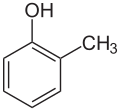Top Qs
Timeline
Chat
Perspective
O-Cresol
Chemical compound From Wikipedia, the free encyclopedia
Remove ads
ortho-Cresol (IUPAC name: 2-methylphenol, also known as 2-hydroxytoluene or ortho-toluenol) is an organic compound with the formula CH3C6H4(OH). It is a colourless solid that is widely used intermediate in the production of other chemicals. It is a derivative of phenol and is an isomer of p-cresol and m-cresol.[3]
Remove ads
Natural occurrences
o-Cresol is one of the chemical compounds found in castoreum. This compound is gathered from the beaver's castor glands and found in the white cedar consumed by the beaver.[4]
o-Cresol is a constituent of tobacco smoke.[5]
Production
Together with many other compounds, o-cresol is traditionally extracted from coal tar, the volatile materials obtained in the production of coke from coal. A similar source material is petroleum residues. These residue contains a few percent by weight of phenol and isomeric cresols. In addition to the materials derived from these natural sources, about two thirds of the Western world's supply is produced by methylation of phenol using methanol. The alkylation is catalysed by metal oxides:
- C6H5OH + CH3OH → CH3C6H4OH + H2O
Over-methylation gives xylenol. Many other production methods have been examined, including oxidative decarboxylation of salicylic acid, oxygenation of toluene, and hydrolysis of 2-chlorotoluene.[3]
Remove ads
Applications
o-Cresol is mainly used as a precursor to other compounds. Chlorination and etherification gives members of commercially important herbicides, such as 2-methyl-4-chlorophenoxyacetic acid (MCPA). Nitration gives dinitrocresol, a popular herbicide. Kolbe–Schmitt carboxylation gives o-cresotinic acid, a pharmaceutical intermediate. Carvacrol, essence of oregano, is derived by alkylation of o-cresol with propene. The muscle relaxant mephenesin is an ether derived from o-cresol.[3]
Health effects
Most exposures to cresols are at very low levels that are not harmful although, like phenols, cresols are skin irritants. When cresols are inhaled, ingested, or applied to the skin at very high levels, they can be harmful. Breathing high levels of cresols for a short time results in irritation of the nose and throat. Aside from these effects, very little is known about the effects of breathing cresols at lower levels over longer times. The acute LD50 for oral ingestion by mice is 344 mg/kg.[3]
Remove ads
References
External links
Wikiwand - on
Seamless Wikipedia browsing. On steroids.
Remove ads




